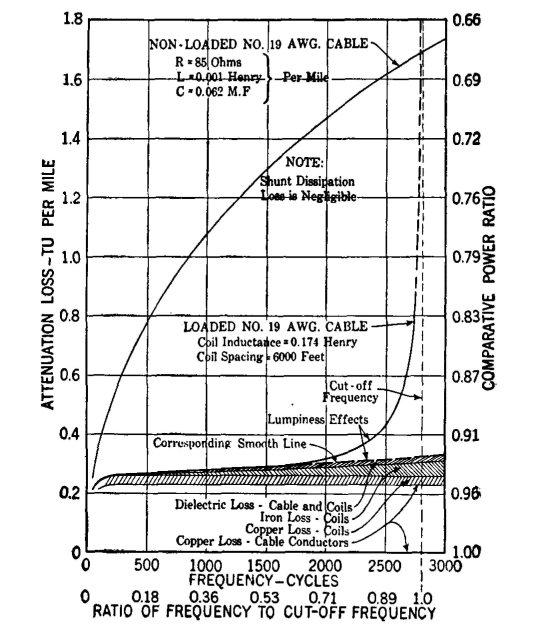| Electrical Communication is a free textbook on the basics of communication technology. See the editorial for more information.... |

|

Home  Cables and Wave Guides Cables and Wave Guides  Transmission Characteristics of Coil-Loaded Cables Transmission Characteristics of Coil-Loaded Cables |
|||






|
|||
Transmission Characteristics of Coil-Loaded CablesCables are loaded to approach the relation LG = CR by inserting inductance, in the form of ferromagnetic-cored coils, in series with the wires at regular intervals, The desired relation could be achieved by altering other constants. However, when all factors are carefully studied, the conclusion is reached that adding inductance is the most satisfactory means. The condition LG = CR is approached but not reached; among the reasons for this are the facts that adding inductance in the form of coils, called lump loading, also adds effective resistance, and also that a heavily coil-loaded circuit (one to which much inductance has been added) has a low velocity of propagation (Table III) and tends to accentuate echo effects (page 409), A comparison of the attenuation losses in a non-loaded and a loaded cable circuit is shown in Fig. 11. In the non-loaded circuit the loss is about four times as great at 2000 as at 200 cycles, and considerable frequency distortion would result. The loss is not only much lower in the loaded circuit but also fairly constant until the vicinity of the cutoff frequency. The "lumpiness effect" is due11 "to repeated internal reflections at points of electrical discontinuity in the line caused by the insertion of the loading coils."
The velocity of propagation for the non-loaded and loaded cable is shown in Fig. 12. As indicated, for the non-loaded circuit the wave velocity at 2000 cycles is more than three times as great as at 200 cycles, thereby causing delay distortion. It is important to note that, although the wave velocity of the particular loaded circuit shown is fairly constant, it is very low, a condition accentuating echo effects.
|
|||
Home  Cables and Wave Guides Cables and Wave Guides  Transmission Characteristics of Coil-Loaded Cables Transmission Characteristics of Coil-Loaded Cables |
|||
Last Update: 2011-05-30


